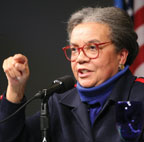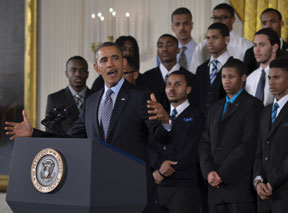 Praise for new rules on Racial Disparities in schools
Praise for new rules on Racial Disparities in schools
Marian Wright Edelman, the president of the Children’s Defense Fund
By Freddie Allen NNPA Senior Washington Correspondent
WASHINGTON, D.C. – Civil rights advocates praised the updated guidelines for addressing racial disparities in American public schools recently issued by the Office of Civil Rights (OCR) at the Department of Education and recommended additional measures to close the Black-White achievement gap.
“The Department’s Office for Civil Rights (OCR) enforces Title VI of the Civil Rights Act of 1964 which prohibits discrimination on the basis of race, color, or national origin, in pro-grams and activities receiving Federal financial assistance,” stated the guidance. “School districts that receive federal funds must not intentionally discriminate on the basis of race, color, or national origin, and must not implement facially neutral policies that have the unjustified effect of discriminating against students on the basis of race, color, or national origin.”
In a recent blog post on the new guidelines on equal access to educational resources Catherine Lhamon, the assistant secretary for civil rights at the U.S. Department of Education said that all students deserve equal access to educational resources like academic and extracurricular programs, strong teaching, facilities, technology and instructional materials, no matter their race, color or national origin.
“Our most recent Civil Rights Data Collection shows that only two out of three Latino high school students and three out of five Black high school students attend schools that offer the full range of math and science courses, defined by OCR as Algebra I, geometry, Algebra II, calculus, biology, chemistry and physics,” said Lhamon.
The guidance, issued in the form of a “dear colleague” letter said that “schools serving more students of color are less likely to offer advanced courses and gifted and talented programs than schools serving mostly white populations, and students of color are less likely than their white peers to be enrolled in those courses and programs within schools that have those offerings.”
The guidance also stated that almost one in five Black high school students attend a high school that does not offer Advanced Placement (AP) courses, a higher proportion than any other racial group.
New Rules on Racial Dis-parities in Schools, the president and interim executive director of the National Alliance of Black School Educators (NASBE), a non-profit group dedicated to improving both the educational experiences and accomplishments of Black youth, said that because classes like Calculus and Algebra are gatekeepers, educational disparities need to be addressed much earlier in the academic careers of Blacks students.
“You have teachers teaching math who are trained in social studies. That’s criminal and that’s happening in multiple states,” said Hamilton.
Black youth today are not receiving access to high quality instructional practices in the classroom, said Hamilton, and that’s greatest civil rights issue affecting Black students.
Hamilton called the suspension rates among Black school preschool students shocking and deplorable and said that it doesn’t make sense that educators and those that are guarding the purse strings and monitoring what’s happening day-to-day are not doing better with the youngest students.
According to the department’s own data, Black students receive suspensions at much higher rates than their white classmates and even though Black children account for less than 20 percent of all preschoolers, they account for almost 50 percent of all out-of-school suspensions in that age group.
Hamilton added that it doesn’t take a genius to see that some folks aren’t comfortable with Black kids and, as a result of their unease, the teachers suspend Black children faster instead of providing the cultural support that is necessary to en-sure that they succeed in the classroom.
“It’s obvious that cultural sensitivity training is needed,” said Hamilton.
Hamilton recommended that the Department of Education spend more time on providing guidance on cultural sensitivity, not only for White teachers, but for Black teachers as well, because a lot of the Black teachers get hired by White school administrators, principals and superintendents. Although they are African American, their training often doesn’t have the same kind of cultural sensitivity that graduates get from historically Black colleges and Universities, added Hamilton.
While continuing a much-needed dialogue on the impact of race and culture on academic achievement, civil rights leaders also praised the Education Department’s renewed efforts to stamp out discrimination in American schools.
Marian Wright Edelman, the president of the Children’s Defense Fund, a non-profit child advocacy group said that as opportunity gaps widen for poor children and children of color, the new guidance offers hope and protection from discrimination.
“The department now makes it clear that states, school districts and schools must provide education resources that are equally available to all students without regard to race, color or national origin,” said Edelman.
Edelman continued: “This is the unfinished business of the Civil Rights movement and a giant step forward for poor children, often children of color, currently taught at higher rates by inexperienced, unqualified or out of field teachers and with far fewer resources than their wealthier peers. Our job now is to ensure that children truly benefit.”
Wade Henderson, the president and CEO of the Leadership Conference on Civil and Human Rights, a diverse alliance of civil and human rights groups, agreed.
“Sixty years since the Supreme Court decided Brown v. Board, states and districts across the country continue to undermine the principle of equality and fairness in education,” said Henderson. “Our public schools, now majority-minority, are bastions of state-sponsored inequality and segregation. In Texas, Kansas and other states, deprived students have turned to state courts to keep school doors open, fix dilapidated facilities, and provide textbooks and other basic materials. Until resources are provided to address these shameful conditions, states will be incapable of honoring commitments to narrow achievement gaps and reduce dropout rates.”
Henderson recognized that the OCR guidance “is not a panacea for the deep-rooted disparities in our nation’s schools” adding that, “It is a commitment from the federal government to continue delivering on its historic obligation to protect students from discrimination.”
Lhamon said that since the start of the Obama Administration, OCR has received more than 260 complaints related to resource equity and launched 33 investigations of states, school districts and schools.
Although Hamilton approved of the updated measures on resource equity issued by the Education Department, Hamilton didn’t see how the department was going to monitor everything that they wanted to at the state and local levels without plenty of help from community stakeholders and school administrators, and that can be problematic.
When it comes to self-reporting civil rights violations in schools “sometimes you need someone who is not going to have dinner with you,” monitoring the progress that schools are making said Hamilton.

